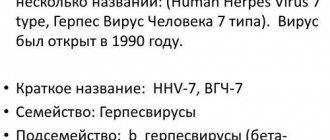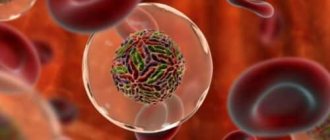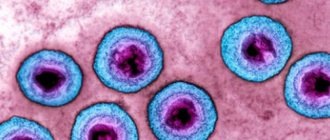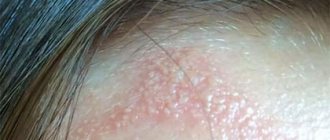Herpes virus type 6 (HHV-6) is a DNA virus that belongs to the family Herpesviridae and subfamily Betaherpesvirinae of the genus Roseolavirus. The infectious disease is widespread in the human population; more than 80% of people are infected with herpes type 6. Humans are the only carrier of virions and the source of infection for surrounding people. Human herpes virus type 6 (HHV-6) is one of 8 herpes viruses known to modern medicine. Its study continues to this day; every year science gains new knowledge about the negative effect of infection on human health and the role of virus infection in the development of diseases in various organs and systems.
Herpes type 6 - what is it?
Human herpes virus type 6 is a beta herpesvirus that causes sudden exanthema in children, mononucleotide-like syndrome, chronic fatigue syndromes and encephalomyelitis. In patients with AIDS, herpes type 6 stimulates the development of oral cervical carcinomas.
Also, type 6 herpes can provoke the development of Sjögren's syndrome, lymphogranulomatosis, malignant cellular lymphomas, sarcoidosis, and febrile seizures in children.
Cases of severe herpes hepatitis associated with herpes virus type 6 have been reported. At the same time, the course of such hepatitis is predominantly fulminant (sudden and rapidly developing) in nature and often ends in death.
Treatment
Antiviral agents
The main drug used successfully to treat herpes virus infection is Acyclovir. But herpes virus type 6 has low sensitivity to the drug.
Valaciclovir is considered a more effective treatment for diseases caused by herpes virus type 6. The disadvantage of the medicine is the lack of pharmaceutical forms for injection. In the presence of severe forms of the disease, treatment with Valaciclovir will not give the desired result. Herpes virus type 6 is highly sensitive to the drug Famciclovir. It is prescribed in cases of ineffective therapy with Acyclovir.
Treatment with Ganciclovir gives good results. The disadvantage of the drug is its high toxicity. It can only be prescribed when diagnosing severe forms of infection that cause serious organ damage.
Valaciclovir is considered a more effective treatment for diseases caused by herpes virus type 6.
The bioavailability of Valganciclovir is several times higher than that of Ganciclovir. The drug is prescribed for advanced forms of herpes virus infection. Contraindications include age under 12 years, pregnancy and breastfeeding.
If a herpes virus infection causes pathological conditions in a patient that threaten his life, the newest drugs Cidofovir or Brivudine can be used. Powerful medications can cope with severe forms of the disease, but are difficult for the body to tolerate.
Treatment of the disease should only be carried out by a doctor (more details here). Incorrect use of antiherpetic drugs can cause progression of the disease, severe adverse reactions and the development of viral resistance to medications.
Immunotherapy
The main reason for the development of acute forms of herpesvirus infection is decreased immunity. Immunotherapy helps restore the body's natural defenses, allowing it to fight the herpes virus on its own. It significantly increases the effectiveness of antiviral therapy, improves the patient’s condition and helps avoid the development of complications.
Treatment with immunostimulants allows you to reduce the dosage of antiviral drugs and shorten the course of treatment, minimizing adverse reactions.
To support the immunity of patients suffering from herpes virus infection, interferon and immunoglobulin preparations are used. For multiple sclerosis, beta-interferon drugs are indicated. They increase the effectiveness of antiviral therapy in 60% of cases.
For other types of diseases caused by herpes virus type 6, it is recommended to prescribe immunoglobulins. Medicines can reduce the dosage of hormonal or pain medications often prescribed for herpesvirus infections.
Triple therapy, including Valaciclovir, alpha-interferon and immunoglobulin, is considered the most effective today.
When the first signs of the disease appear, you should immediately consult a doctor.
When the first signs of the disease appear, you should immediately consult a doctor.
Herpesvirus type 6 - features
Herpes virus type 6 differs from other herpes viruses in biological and immunological properties, as well as in the antigenic structure and type of cells sensitive to the virus (target cells).
In terms of genome structure, herpes virus type 6 is most similar to CMV (cytomegalovirus).
Important. Herpes type 6 is characterized by a high affinity for CD4+ lymphocytes, and therefore can significantly aggravate the course of HIV infection, provoking the rapid development of complications.
Also, herpes virus type 6 is capable of infecting CD3+, CD5+, CD7+, CD8– lymphocyte cells, monocyte-macrophage cells, megakaryocytes, glial cells, and thymus cells.
Due to this, there is a pronounced lymphoproliferative and immunosuppressive effect of the virus on the human body.
The growth cycle of the virus lasts four to five days.
Prevention
Prevention of herpes virus infection involves maintaining a healthy lifestyle. In order for the virus to “sleep” and not become active, you need to:
- exercise and lead an active lifestyle;
- provide nutritious and varied nutrition;
- avoid crowded places, especially during epidemics;
- do not use other people's things;
- observe sleep and wakefulness, work and rest;
- regularly spend time in the fresh air and periodically travel to nature;
- avoid stress.
How is herpes type 6 transmitted?
The source of the virus is a sick person or a healthy virus carrier.
The largest amount of herpes type 6 is found in saliva and mucus of the nasopharynx, so the main route of transmission of the herpes virus is airborne.
The virus can also be transmitted transplacentally (during pregnancy - from mother to fetus).
Herpes virus type 6 is not transmitted through breast milk.
Sexual transmission of infection is practically not recorded and has no clinical significance in the spread of infection. Also, in isolated cases, infection with the virus is observed through blood transfusions, organ and tissue transplants.
Primary infection most often occurs before the age of three.
For reference. Children in the first three months of life do not suffer from herpes type 6, since maternal antibodies to the virus circulate in their blood.
In approximately seventy percent of cases, the infection in children is asymptomatic or in an erased form.
It is also possible to develop sudden exanthems in newborns (the most common symptoms of herpesvirus type 6 in children).
In adult patients, primary infection with herpes type 6 is extremely rare and, as a rule, occurs in the form of infectious mononucleosis (if infectious mononucleosis develops, the patient should be thoroughly examined for Epstein-Barr and cytomegalovirus infection, since this disease is more often caused by these types of herpes).
Less commonly observed is the formation of chronic fatigue syndrome or histiocytic necrotizing lymphadenitis.
Severe infection (fulminant hepatitis, generalized herpes) is recorded extremely rarely, in weakened patients or patients with immunodeficiencies.
Routes of infection
Viral agents are found in saliva, vaginal secretions, blood, cerebrospinal fluid and sputum. Known methods of infection:
- by airborne droplets,
- vertical transmission to the child from the mother during labor,
- contact method of infection (including the possibility of infection through kissing and sexual intercourse),
- during medical procedures - during blood transfusion and during operations.
The latest research has proven the possibility of transmitting a virus integrated into the DNA of the parents already at the moment of conception.
Primary infection usually occurs in childhood. The younger the child, the more severe the infection. In this case, a stable immunity is formed, suppressing the development and external manifestations of the disease throughout a person’s life.
Carriers of the virus usually do not know about its presence in the body. Even in the absence of pronounced symptoms, the disease can be transmitted from them to healthy people.
Pathogenesis of infection development
For reference. The virus has a high degree of tropism for lymphocyte cells. After infection, the herpes virus type 6 penetrates T-lymphocyte cells, where the process of its active reproduction begins.
After this, the virus spreads throughout the body and can infect:
- lymphoid tissues;
- brain tissue;
- liver;
- salivary glands;
- vascular endothelium.
Due to its pronounced immunosuppressive effect, the virus can significantly aggravate the course of HIV infection, provoking the rapid progression of infection and the development of tumor complications.
Just like other herpes viruses, herpes type 6 persists in the body for life. Exacerbation of infection occurs with decreased immunity.
For reference. If the level of immune reactions is sufficient to suppress the activity of the virus, the herpes virus type 6 may remain in a latent (sleeping, inactive) phase throughout the patient’s life.
Primary infection
The manifestation of primary infection occurs in early childhood, most often during the life of a child from 6 months to 4 years. This is due to the high virulence and prevalence of the virus among the population. For up to six months, the baby’s blood contains antibodies against the infection that he received from his mother at birth. By the age of 6 months, the concentration of specific antibodies decreases and the child becomes susceptible to infection.
In rare cases, if the mother is not infected with herpes type 6, primary infection of the child may occur in the first months after birth. In this case, the disease is usually more severe. The child’s first contact with the infection leads to the formation of stable immunity, which prevents relapse of the disease in the future and reduces the risk of complications. Primary infection can be considered as a “vaccination” against the disease.
Routes of infection:
- airborne;
- contact;
- transplantation (for organ transplantation);
- blood transfusion (during blood transfusion, during surgical procedures);
- during childbirth from mother to child.
The virus is found in saliva, cerebrospinal fluid, blood, and sputum.
After the body's first contact with type 6 herpes, the immune system produces antibodies. In the first 3-4 days after infection, class M immunoglobulins (IgM) are synthesized, which remain in the blood for 4-6 weeks. They testify in favor of the acute phase of the disease or relapse. On days 7-10 of infection, immunoglobulins of class G (IgG) appear in the blood, which persist throughout life. This type of antibody speaks in favor of the disease, the latent course of the infection.
After primary infection, virions are retained in the host body - they persist. They are in a latent state in macrophages, lymph nodes, monocytes and lymphocytes of peripheral blood, and salivary gland cells. Persistence means that the virus remains in an inactive state in human cells. The vital activity of the virus is suppressed by the immune system.
An infection can manifest itself when the body’s defenses are significantly reduced, when the virus multiplies, destroys host cells, enters the bloodstream and spreads through the bloodstream throughout the body. Activation of the infection leads to damage to various internal organs: lungs, brain, kidneys, salivary glands, and organs of vision.
Herpes type 6 - symptoms
Herpes type 6 causes a wide range of diseases, so the symptoms will depend on the pathology that has developed.
During primary infection, herpes virus type 6 can provoke the development of:
- chronic fatigue syndromes (myalgic encephalomyelitis);
- sudden exanthems in newborns;
- infectious mononucleoses not associated with Epscheten-Barr virus and cytomegaloviruses (this type of infectious mononucleosis is most often observed in adults and adolescents);
- histiocytic necrotic lymphadenitis.
When the infection recurs, herpesvirus type 6 can cause the development of:
- lymphoproliferative pathologies (lymphadenopathy, immunodeficiency, polyclonal lymphoproliferation);
- malignant lymphomas (non-Hodgkin lymphomas, peripheral T-cell leukemia, B-cell type lymphomas, dermatopathic lymphadenopathy, lymphogranulomatosis, sinusoidal B-cell lymphomas, pleomorphic T-cell lymphomas).
Possible complications
The diseases from the list below do not necessarily appear due to herpes type 6. There is a possibility that the exacerbation of the herpes virus, on the contrary, is caused by these diseases. If HHV-6 is present in the body, pathologies such as:
- multiple sclerosis;
- liver failure;
- diseases associated with oncology;
- meningoencephalitis;
- optic neuritis;
- and other dangerous diseases.
The pathogen itself is not so dangerous; it works in conjunction with other diseases and aggravates their course. But the presence of HHV-6 is very dangerous in AIDS.
Due to the possible complications of herpes and the pathologies that it causes, it is necessary to begin therapy as soon as the first signs appear indicating the presence of the pathogen in the body.
Diagnosis of herpes type 6
Analysis for herpes type 6 involves immunological diagnostics, PCR and electron microscopy.
For reference. Herpes simplex virus type 6 IgG is positive in approximately 90% of adult patients, so a single increase in antibody titer is not a reliable diagnostic criterion.
To make a diagnosis based on one test, it is necessary either for the patient to have a negative test done earlier, or for a 4-fold increase in the level of antibodies in the blood.
In the presence of a clinical picture of an acute herpetic infection, the maximum level of antibodies is observed by 2-3 weeks of illness (however, the analysis is informative already from the 7th day of illness).
In addition to testing for herpes type 6, testing for Epstein-Barr viruses and cytomegalovirus infection is recommended.
Diagnosis and treatment
To identify the disease, 2 tests are performed for herpes type 6. The first is the detection of antibodies (IgM, IgG) in peripheral blood using enzyme-linked immunosorbent assay (ELISA). The examination helps determine the stage of the disease and determine immunity to infection. The second is polymerase chain reaction (PCR) to determine the genetic material of the pathogen. The analysis makes it possible to determine the presence of herpes type 6 in saliva, blood, and cerebrospinal fluid with a high degree of probability and to identify the severity of the disease.
Infection with herpes virus type 6 does not require treatment. Children are prescribed multivitamins, plenty of fluids (fruit juice, herbal tea, mineral water), antipyretic drugs (Panadol, Nurofen), immunomodulatory herbal products (Echinacea, Immunal). Specific antiviral therapy is carried out in case of severe disease with damage to internal organs and the nervous system. The attending physician decides how to treat the infection depending on the state of immunity and clinical manifestations.
Medicines for the treatment of herpes
Treatment of herpes type 6 in adults is carried out with antiviral drugs:
- cidofovir;
- lobucovir;
- foscarnet;
- adefovir;
- ganciclovir.
Medicines are prescribed from the age of 12; at an earlier age, antiviral therapy is carried out for health reasons.
Prevention of recurrence of infection:
- good nutrition;
- physical education and sports;
- rejection of bad habits;
- optimal daily and wakefulness regime;
- fight against colds, chronic diseases, stress;
- walks in the open air.
So what is herpes type 6 and why is this type of infection dangerous? With a normal level of immunity, the disease does not cause dangerous consequences. Strengthening the body's defenses and timely treatment of immunodeficiency conditions allows one to avoid severe complications and deterioration of health against the background of exacerbation of viral infection.
Tweet
Pin It
- Why is the herpes virus dangerous?
- Intestinal herpes: symptoms and treatment
- Consequences and complications after herpes
- When to be wary of herpes in early pregnancy
Diagnosis of herpes virus
If you suspect a virus, you should definitely consult a doctor and get tested. Diagnosis usually includes blood tests, but it is also possible to examine other bodily fluids: saliva, cerebrospinal fluid.
| Study | The essence of the analysis | Preparation | Result |
| Blood PCR | During the research process, the DNA of the virus or its particles is detected. | Preparation is the same as for any blood test. It is advisable to take it on an empty stomach in the morning. It is not advisable to drink alcohol before the study. | The result is usually clear: “detected” or “not detected.” |
| Saliva PCR | The DNA content of the virus is also determined, but in saliva. | Before the study, you should not use throat sprays, brush your teeth, or chew gum. You just need to rinse your mouth with boiled water. | The result indicates "detected" or "not detected". There is no intermediate result. |
| ELISA | The test is designed to detect antibodies to the virus antigen in the blood. | The preparation is standard. The patient comes to the office on an empty stomach. A few days before donating blood, it is not advisable to drink alcohol or take any medications. | The result can be either positive (IgG greater than 1.1), negative (IgG less than 0.9), or questionable (0.9-1.1). In the latter case, you will have to retake the analysis after some time. |
More information about the herpes virus can be found in the video:
Read: Staphylococcus aureus in the intestines: symptoms and treatment of infection
Consequences of the disease
Each disease has its consequences, including the herpes virus. If you do not notice herpes in your baby in time, it can lead to fever and convulsions, which is very dangerous for the child. If you don't call a doctor, this will lead to epilepsy.
Adverse consequences also include tonsillitis, liver disease, tonsils, poor vision or central nervous system damage. If you seek qualified help in time, then adverse consequences can be avoided.
Important: if a child develops seizures or epilepsy, a neurologist will be involved in diagnosis and treatment. If pneumonia has developed - a pulmonologist, myocarditis - a cardiologist, hepatitis - a gastroenterologist. In any situation, consultation with an immunologist is important.
The symptoms in adults and children are almost the same, so identifying the disease will not be difficult. In some cases, you will need to undergo a set of tests that can make an accurate diagnosis. If you already have herpes in your body, then nothing can be done, you just have to maintain a healthy tone.
5 / 5 ( 5 votes)











